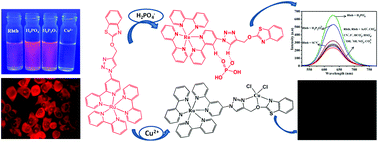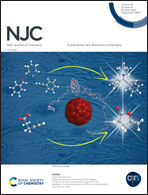Triazole appending ruthenium(ii) polypyridine complex for selective sensing of phosphate anions through C–H–anion interaction and copper(ii) ions via cancer cells†
Abstract
A new ruthenium(II) polypyridine-based complex, [RuII(bpy)2(Btb)] 2PF6− (Rbtb) {bpy = 2,2′-bipyridine and Btb = 2-((1-([2,2′-bipyridin]-4-yl)-1H-1,2,3-triazol-4-yl)methoxy)-1,3-benzothiazole}, was constructed using a 1,2,3-triazole linker holding a benzothiazole moiety. The complex was confirmed by FT-IR, 1H NMR, 13C NMR, and mass spectroscopy. The detection properties were thoroughly checked with various anions and cations. The emission spectrum revealed that luminescence is enhanced by H2PO4−/H2P2O72− anions by ∼2.3/1.9-fold in CH3CN and quenched (nearly 80%) by Cu2+ ions in CH3CN/10 mM HEPES buffer (pH = 7.4; 9/1 v/v). The 1H NMR titration result exhibits basic H2PO4−/H2P2O72− anions interacting with acidic triazole C–H, as observed from the downfield shift. The increase and decrease of lifetime obeys the emission result, along with disturbance of the probe structural motif upon binding with anions (mainly by C–H⋯anion interaction) and cations (photoinduced electron transfer), respectively. Better detection limit and binding constant values were obtained for Rbtb upon treatment with H2PO4−/H2P2O72− anions (0.22/0.31 μM and 7.7/4.2 × 104 M−1) and Cu2+ ions (0.7 μM and 5.11 × 104 M−1). The generation of a new separate redox couple was noticed at 0.94 V and 0.45 V due to the interaction of H2PO4−/H2P2O72− anions and Cu2+ ions, respectively. The 1 : 1 binding ratio of Cu2+ ion with Rbtb was established by mass spectrum, and square-based geometry of Rbtb–Cu2+ was identified according to the EPR spectrum (g‖ > g⊥ > 2.0023 and A‖ = 134 × 10−4 cm−1). Consequently, the luminescence intensity of Ru(bpy)3 core is further tuned even with the disturbance of the acidic C–H proton of 1,2,3-triazole by H2PO4−/H2P2O72− anions. Here, 1,2,3-triazole could not coordinate primarily to ruthenium(II), but bonded directly to the 4th position of 2,2′-bipyridine in the primary ruthenium complex core. Rbtb exhibited low cytotoxicity against MCF-7 cell lines and was used for live-cell imaging of Cu2+ ion. The biological study shows that the complex stained the cytoplasm and nuclear membrane of the cells and specifically binds with the metal ion.



 Please wait while we load your content...
Please wait while we load your content...